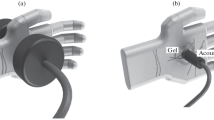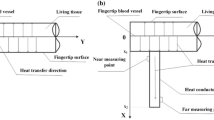Abstract
A minimally invasive approach was proposed to measure local blood perfusion rate in living tissues, based on the well-known Pennes bioheat equation. The measuring probe consists of a heater covered with conductive epoxy and temperature sensor deposited on the probe–tissue interface. By monitoring the probe–tissue interface’s temperature response before and after employing the constant heat flux, the tissue blood perfusion rate can be obtained. A theoretical model was developed to describe the measurement system. In vivo experiments were performed on the rabbit’s thighs to validate this method. At last, uncertainties implied in the temperature measurement and voltage across the heater was evaluated. The results point out the way to improve the accuracy of the present method and its appropriate application occasion.








Similar content being viewed by others
Abbreviations
- C :
-
Specific heat of tissue (J/kg K)
- C b :
-
Specific heat of blood (J/kg K)
- K :
-
Thermal conductivity of tissue (W/m K)
- Q m :
-
Metabolic rate of tissue (W/m3)
- q 0 :
-
Heat flux passing from the bead to the tissue (W/m2)
- R :
-
Resistance of the heating wires embedded in the bead (Ω)
- R 0 :
-
Bead radius (m)
- T :
-
Tissue temperature (°C)
- T 0 :
-
Initial tissue temperature (°C)
- T a :
-
Artery temperature (°C)
- t :
-
Time (ms)
- U :
-
Voltage across the heating wires (V)
- ΔU :
-
Uncertainty of the voltage (V)
- W b :
-
Blood perfusion rate (kg/m3 s)
- ΔW b :
-
Uncertainty of the predicted blood perfusion (kg/m3 s)
- r :
-
Coordinate (m)
- α:
-
Thermal diffusivity of tissue (m2/s)
- θ:
-
Temperature elevation due to external heating (°C)
- \({\theta_{{R_{0}}}}\) :
-
Temperature elevation at the bead-tissue interface due to external heating (°C)
- \({\Delta \theta_{{R_{0}}}}\) :
-
Uncertainty of the temperature (°C)
- ρ:
-
Density of tissue (kg/m3)
- ρ b :
-
Density of blood (kg/m3)
References
Anderson GT, Burnside G (1990) A noninvasive technique to measure perfusion using a focused ultrasound heating sources and a tissue surface temperature measurement. Advances in measuring and computing temperatures in biomedicine: HTD-vol.147, The winter annual meeting of ASME, Dallas, Texas, pp 31–35
Anderson GT, Valvano JW, Santos RR (1992) Self-heated thermistor measurements of perfusion. IEEE Trans Biomed Eng 39:877–885
Arkin H, Holmes KR, Chen MM (1986) A sensitivity analysis of the thermal pulse decay method for measurement of local tissue conductivity and blood perfusion. ASME J Biomech Eng 108:208–214
Arkin H, Holmes KR, Chen MM (1989) A technique for measuring the thermal conductivity and evaluating the ‘apparent conductivity’ concept in biomaterials. ASME J Biomech Eng 111:276–282
Balasubramaniam TA, Bowman HF (1974) Temperature field due to a time dependent heat source of spherical geometry in an infinite medium. ASME J Heat Transf 93:296–299
Castellana FS, Skalak R, Cho JM, Case RB (1983) Steady-state analysis and evaluation of a new thermal sensor for surface measurements of tissue perfusion. Ann Biomed Eng 11:101–115
Chato JC (1968) A method for the measurement of thermal properties of biological materials. Thermal problems in biotechnology, American society of mechanical engineers, LCN068–58741, New York, pp 16–25
Chen MM, Holmes KR (1984) The thermal pulse-decay method for simultaneous measurement the thermal conductivity and local blood perfusion rate of living tissues. Advances in bioengieering. Sponsored by: ASME, pp 113–115
Fouquet Y, Hager JM, Terrell J, Diller TE (1993) Blood perfusion estimation from noninvasive heat flux measurements. In: Roemer RB (ed) Advances in bio-heat and mass transfer: microscale analysis of thermal injury processes, instrumentation, modeling, and clinical applications. ASME, New York, pp 53–60
Holmes H R (1997) Biological structures and heat transfer report from the Allerton Workshop on the Future of Biothermal Engineering.
Holti G, Mitchell KW (1979) Estimation of the nutrient skin blood flow using a non-invasive segmented thermal clearance probe. In: Rolfe P (ed) Non-invasive physiological measurements, vol 1. Academic Press, London, pp 113–123
Johnson WR, Abdelmessih AH, Grayson J (1979) Blood perfusion measurements by the analysis of the heated thermocouple probe’s temperature transients. ASME J Biomech Eng 101:58–65
Kline SJ (1985) The purpose of the uncertainty analysis. ASME J Fluids Eng 107:153–160
Kress R, Roemer R (1987) A comparative analysis of thermal blood perfusion measurement techniques. ASME J Biomech Eng 109:218–225
Liu J (2001) Uncertainty analysis for temperature prediction of biological bodies subject to randomly spatial heating. J Biomech 34:1637–1642
Liu J, Wang CC (1997) Bioheat transfer (in Chinese). Science Press of China, Beijing
Liu J, Xu LX (1999) Estimation of blood perfusion using phase shift in temperature response to the sinusoidal heating at the skin surface. IEEE Trans Biomed Eng 46:1037–1043
Michener MD, Hager JM, Terrell JP, Veit H, Diller TE (1991) Noninvasive blood perfusion measurement with a heat flux microsensor. In: McGrath JJ (eds) Advances in biological heat and mass transfer. ASME, New York, pp 1–8
O’Reilly TB, Gonzales TL, Diller TE (1996) Development of a non-invasive blood perfusion probe. In: Hayes LJ, Clegg S (eds) Advances in biological heat and mass transfer, HTD-vol.337/BED, vol 34. ASME, New York, pp 67–73
Ozisik MN (1993) Heat conduction. Wiley, New York
Parker KJ (1981) Ph.D. Thesis, Massachusetts Institute of Technology
Patera AT, Mikic BB, Bowman H (1978) The effect of cylindrical probe geometry on the accuracy of tissue perfusion measurements made with the thermal diffusion probe. ASME Bioeng Proceed 5:157–159
Penns HH (1948) Analysis of tissue and arterial blood temperatures in the resting human forearm. J Appl Physiol 1:93–122
Scott EP, Robinson P, Diller TE (1997) Estimation of blood perfusion using a minimally invasive blood perfusion probe. In: Advances in biological heat and mass transfer, HTD-vol.355/BED, vol 37. ASME, New York, pp 205–212
Valvano JW, Badeau AF (1987) In vivo measurement of instrinsic and effective thermal conductivity using sinusoidally heated thermistors. A technique for measuring the thermal conductivity and evaluating the ‘apparent conductivity’ concept in biomaterials. In: Sixth southern biomedical engineering conference, pp 1a–4a
Valvano JW, Allen JT, Bowman HF (1984) The simultaneous measurement of thermal conductivity, thermal diffusivity, and perfusion in small volumes of tissue. ASME J Biomech Eng 106:192–197
Valvano JW, Badeau AF, Pearce JA (1987) Simultaneous measurement of intrinsic and effective thermal conductivity. In: ASME Winter Annual Meeting, Thermodynamics, Heat and Mass Transfer in Biotechnology. ASME, Boston, pp 1–5
Weinbaum S, Jiji LM (1985) A new simplified bioheat equation for the effect of blood flow on local average tissue temperature. ASME J Biomech Eng 107:131–139
Yuan DY, Valvano JW, Anderson GT (1993) Measurement of thermal conductivity, thermal diffusivity, and perfusion. Biomed Sci Instrum 29:435–442
Zhang HF, He LQ, Cheng SX, Zhai ZT, Gao DY (2003) A dual-thermistor probe for absolute measurement of thermal diffusivity and thermal conductivity by the heat pulse method. Meas Sci Technol 14:1396–1401
Zhong SK, Wu DJ (1982) Concise physical handbook (in Chinese). JiangXi People’s Publishing House, Nanchang
Acknowledgments
This work is partially supported by the National Natural Science Foundation of China.
Author information
Authors and Affiliations
Corresponding author
Appendix: Temperature response of living tissue subjected to constant surface flux heating
Appendix: Temperature response of living tissue subjected to constant surface flux heating
To analyze the transient temperature response of living tissues subjected to the constant surface flux heating, the theoretical model was established as follows,
At the distant site far from the bead, the constant heating almost has no influence on the temperature there. In order to solve the question, at r = R′ = 0.02 m is assumed as the distant site far from the bead. The equilibrium temperature under a constant voltage is the initial temperature at the following heating process. Then boundary and initial conditions to Eq. (A1) can then be expressed as:
Assuming
Then Eqs. (A1–A2a, b, c) are transformed into
If the Green’s function for the above Eq. (A4) is obtained, the transient tissue temperature can easily be constructed [20]. Through introducing an auxiliary problem corresponding to Eq. (A4), the Green’s function can finally be obtained as (detailed derivation is omitted here)
where β m ’s are the positive roots of
Then the tissue temperature field could be constructed with Eq. (A3)
The final solution for bead-tissue interface temperature T(R 0, t ) is therefore in the form of
Rights and permissions
About this article
Cite this article
Lv, YG., Liu, J. Measurement of local tissue perfusion through a minimally invasive heating bead. Heat Mass Transfer 44, 201–211 (2007). https://doi.org/10.1007/s00231-007-0233-z
Received:
Accepted:
Published:
Issue Date:
DOI: https://doi.org/10.1007/s00231-007-0233-z




